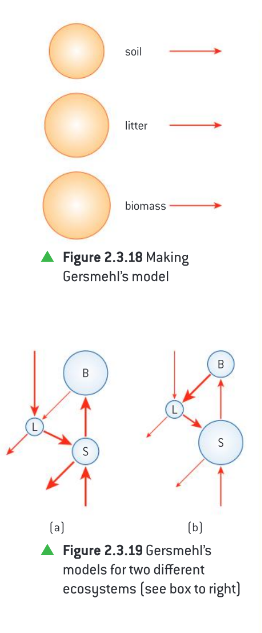2.3 - Flows of energy and matter
1/34
Earn XP
Description and Tags
Name | Mastery | Learn | Test | Matching | Spaced |
|---|
No study sessions yet.
35 Terms
Gross Productivity
The total gain in energy or biomass per unit area per unit time
It is the biomass that could be gained by an organism before any deductions
Net Productivity
The gain in energy or biomass per unit are per unit time that remains after deductions due to respiration
Biomass
The living mass of an organism or organisms, but sometimes referred to as dry mass
Gross Primary Productivity
The total gain in energy or biomass per unit area per unit time by green plants
It is energy fixed by green plants by photosynthesis
Net primary productivity
Calculated by subtracting respiratory losses from GPP
An ecosystem’s NPP is the rate at which plants accumulate dry mass usually measured in g m^-2. The glucose produced in photosynthesis has 2 main fates
Some provides for growth, maintenance, and reproduction
The remainder is deposited in and around cells as new material
NPP = GPP - R
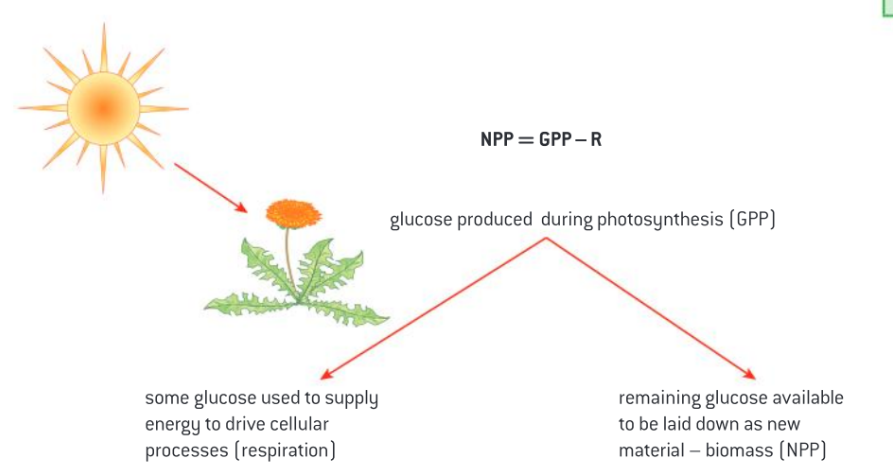
Gross Secondary Productivity
The total energy/biomass assimilated by consumers and is calculated by subtracting the mass of fecal loss from the food eaten
GSP - food eaten - fecal loss
Net Secondary Productivity
The total gain in energy or biomass per unit area per unit time by consumers, after allowing for losses to respiration Calculated by subtracting respiratory losses (R) from GSP
Different things happen to the energy
Some of the assimilated food energy is used in cellular respiration to provide energy for life processes
Some is removed as nitrogenous waste, in most animals as urine
The rest is stored in dry mass of new body tissue
Some will be released as feces
NSP = GSP - R
Pathways of energy through an ecosystem include
Conversion of light energy to chemical energy
Transfer of chemical energy from one trophic level to another with varying efficiencies
Overall conversion of ultraviolet and visible light to heat energy by an ecosystem
Re-radiation of heat energy to the atmosphere
Storages in the carbon cycle include:
Organisms and forests (both organic)
The atmosphere, soil, fossil fuels, and oceans (all inorganic
Flows in the carbon cycle
Consumption
Death and decomposition
Photosynthesis
Respiration
Dissolving and fossilisation
Storages in the nitrogen cycle include:
Organisms (organic)
Soil, fossil fuels, atmosphere, and water bodies (all inorganic)
Flows in the nitrogen cycle include:
Nitrogen fixation by bacteria and lightning
Absorption
Consumption (feeding)
Excretion
Death and decomposition
Dentrification by bacteria in waterlogged soils
Solar Radiation
Made up of visible wavelengths (light) and those wavelengths that humans cannot see (ultraviolet and infrared). Almost all energy that drives processes on Earth comes from the Sun
Some 60% of this is intercepted by atmospheric gases and dust particles.
Solar radiation hitting the Earth diagram
In the Sky/Atmosphere
31% - Total Reflection
69% - Total Absorption
Entering Solar Radiation
49% is absorbed by the Earth’s ground
17% is absorbed by molecules and dust
3% is absorbed by clouds
19% is reflected by clouds
9% is reflected by the ground
3% is reflected by scatter
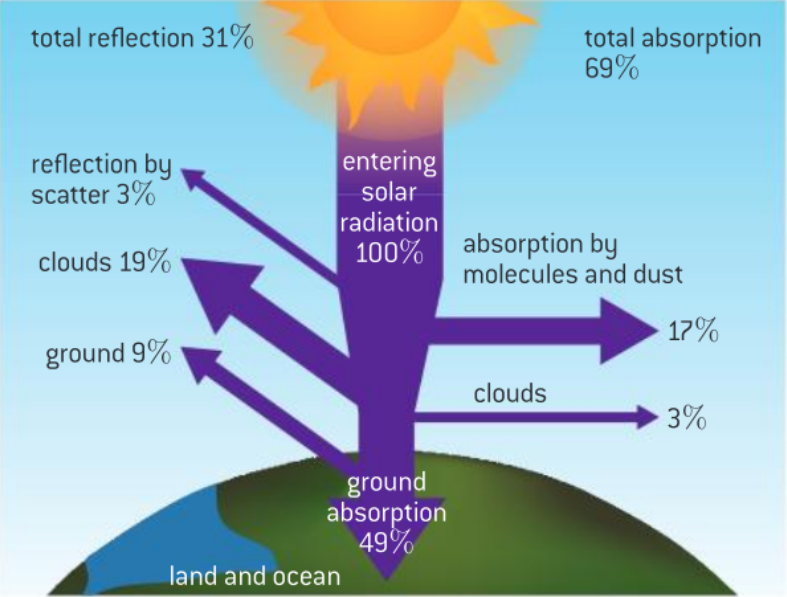
Productivity
The conversion of energy into biomass over a given period of time.
It is the rate of growth or biomass increase in plants and animals.
It is measured per unit area per unit time, eg. per metre² per year

About carnivores and energy
On average they assimilate 80% of the energy in their diets
They egest less than 20%
Usually have to chase moving animals, so higher energy intake is offset by increased respiration during hunting
Biomass is locked up in prey foods - non-digestible skeletal parts, such as bone, horn, and antler
About herbivores and energy
They assimilate about 40% of the energy in their diet
They egest 60%
They graze static plants
Flows of energy and matter table

Carbon Stores
Organic locations
Organisms (biomass) - living plants and animals
Fossilized life forms ex. fossil fuels
Inorganic locations
Sedimentary rocks and fossil fuels
The oceans
Soil
The atmosphere
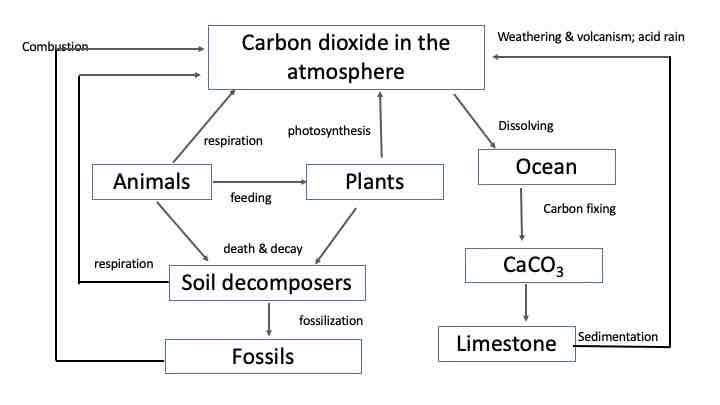
Carbon flows
It cycles between biotic and abiotic chemical cycles
Fixed by photosynthesis and released back to the atmosphere through respiration
Released back to the atmosphere through combustion of fossil fuels and biomass
Respire through the death of organisms
It’s oxidized to become carbon dioxide when fossil fuels are burnt
Plants recapture it through carbon fixation and lock it up in their bodies as glucose
When plants are harvested or cut down, it gets released into the atmosphere
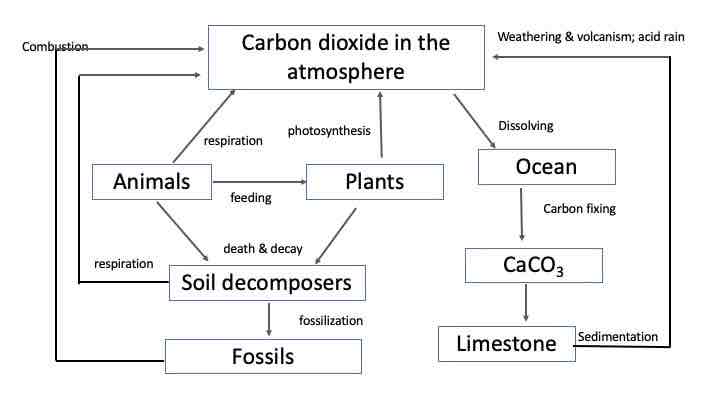
Nitrogen Cycle
For plants to take up nitrogen, it must be in the form of ammonium ions or nitrates
It can be throught of in three basic stages: nitrogen fixation, nitrification, denitrification
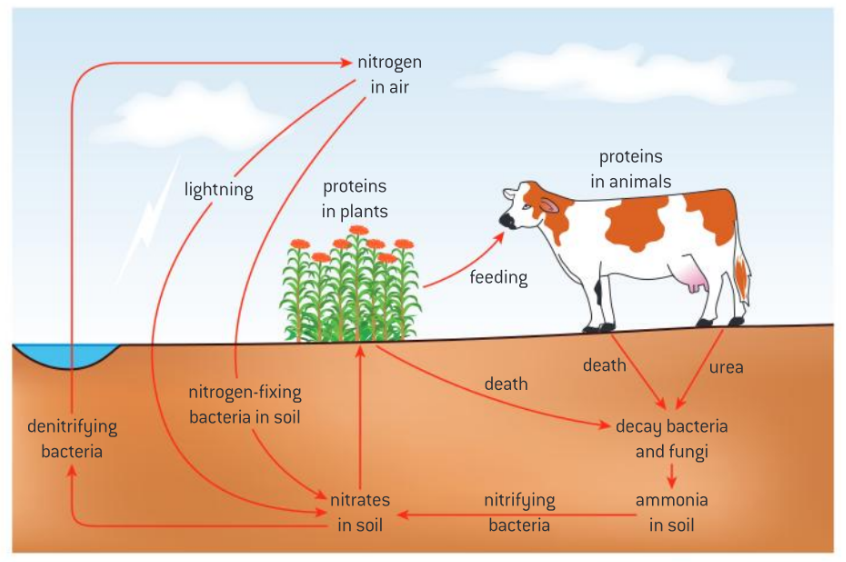
Nitrogen Storages/sinks
Organisms
Soil
Fossil fuels
The atmosphere
Water
Flows in the nitrogen cycle
nitrogen fixation
nitrification
denitrification
feeding
absorption
assimilation
consumption
excretion
death and decomposition
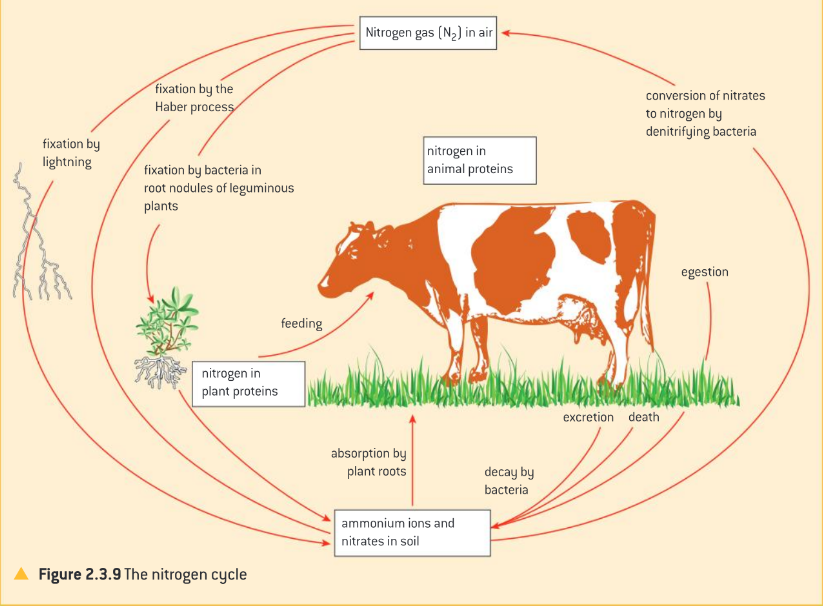
Nitrogen Fixation
When atmospheric nitrogen is made available to plants through the fixation of atmospheric nitrogen. It can be carried out in 5 ways
By nitrogen-fixing bacteria free-living in soil (Azotobacter)
By nitrogen-fixing bacteria living symbiotically in root nodules of leguminous plants (Rhizobium)
By cyanobacteria that live in soil or water. Cyanobacteria are the cause of high productivity in Asian rice fields
By lightning also causing the oxidation of nitrogen gas to nitrate which is washed into the soil
The industrial Haber process is a nitrogen-fixing process used to make fertilizers
Nitrification
Nitrifying bacteria are able to convert ammonium to nitrates (Nitrosomonas) while other bacteria convert the nitrites to nitrates (Nitrobacter) which are then available to be absorbed by plant roots
Denitrification
Denitrifying bacteria in waterlogged and anaerobic conditions reverse this process by converting ammonium, nitrate, and nitrite ions to nitrogen gas, which escapes to the atmosphere
Assimilation
Once living organisms have taken in nitrogen, they assimilate it or build it into more complex molecules.
Decomposition in the nitrogen cycle
Provides nitrogen uptake by plants. Supplies the soil with much more nitrogen than nitrogen fixation processes. Important organisms in decomposition are animals (insects, worms), fungi, and bacteria.
Efficiency of assimilation equation
gross productivity x 100/ food eaten
Efficiency of biomass productivity
net productivity x 100/ gross productivity
Trophic efficiency
The efficiency of transfer from one trophic level to the next, is considered, on average, to be about 10%
Trophic inefficiencies occur because:
Not everything is eaten
Digestion is inefficient (food is lost in feces because the digestive system cannot extract all the energy from it)
Heat is lost in respiration
Some energy assimilated is used in reproduction and other life processes
Energy budget
For an individual animal/population, we can measure the quantities of energy entering, staying within, and leaving the animal or population
Maximum Sustainable Yield
The largest crop or catch that can be taken from the stock of a species (ex. a forest, a shoal of fish) without depleting the stock. It is often used in managing fisheries
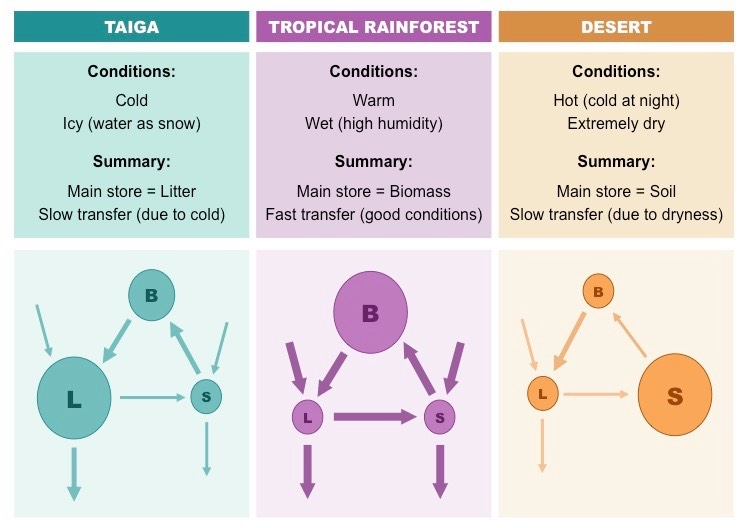
Gersmehl’s Model
Illustrates how nutrients are transferred/and or cycled between nutrient sinks via environmental inputs and output as represented by the arrow in and around each nutrient sink
